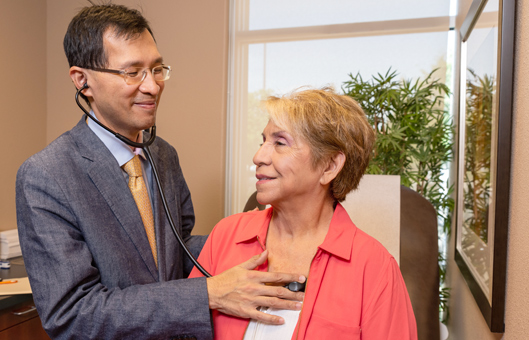CCHLS performs a number of important heart and lung procedures for patients throughout Central California. Advanced, specialized training and broad experience enable us to accomplish positive outcomes in some of the most complicated cases.


CCHLS performs a number of important heart and lung procedures for patients throughout Central California. Advanced, specialized training and broad experience enable us to accomplish positive outcomes in some of the most complicated cases.
Cardiac Surgery
Coronary Artery Bypass Graft [CABG]
When coronary arteries (the arteries that deliver blood to your heart) become blocked, we may perform surgery to give blood a new pathway to the heart. During coronary artery bypass graft surgery (also called CABG, or “cabbage”), a blood vessel is removed or redirected from one area of the body and placed around the area or areas of narrowing to bypass the blockages. This allows blood flow to be restored to the heart muscle. This vessel is called a graft. With more than 500,000 performed each year heart bypass surgery is among the most common operations performed in the US.
On-Pump CABG
During the traditional “on-pump” surgery, a heart-lung bypass machine takes over the work of the heart and lungs. This allows the heart to be completely at rest while the surgeon performs the bypass surgery. The heart-lung machine also helps your body receive the oxygen and blood flow it needs during the surgery. The on-pump operation is the most common CABG surgery.
Off-Pump CABG
Off-pump or beating heart bypass surgery allows surgeons to perform surgery while the heart is still beating. The heart-lung machine is not used. Advanced operating equipment is used to stabilize/hold portions of the heart and bypass the blocked artery. Meanwhile, the rest of the heart keeps pumping and circulating blood to the body.
Hybrid Coronary Artery revascularization
Hybrid revascularization is a combination of coronary artery bypass surgery (CABG) and percutaneous coronary intervention (PCI) performed either during the same procedure or in a staged approach. Percutaneous coronary intervention is used to restore blood flow to the heart’s muscle after arteries become narrowed or blocked. The treatment is minimally invasive and relies on thin tubes called catheters. A catheter is inserted into an artery in the wrist or leg, and then threaded to the heart. We use contrast dye and X-rays to guide our work. This imaging procedure is called an angiogram and is a type of cardiac catheterization.
Open Aortic Arch Repair
Aortic Arch Repair is indicated for aneurysmal (a balloon-like dilation) disease of the aortic arch. Aortic arch procedures require temporary interruption of the blood flow to the blood vessels that supply the brain. The aortic arch is replaced with a synthetic tube that is attached to normal segments of the ascending and descending thoracic aorta. The arch blood vessels (brachiocephalic, left carotid, and left subclavian arteries) that supply the brain among other organs are reconnected to the synthetic graft with a separate synthetic tube that has three branches (trifurcation graft). While all these connections are being created, this novel technique allows for insertion of catheters in the individual arch blood vessels for perfusion of the brain with blood (selective cerebral perfusion).
Abdominal Aortic Aneurysm Surgery
When the wall of a blood vessel weakens, a balloon-like dilation called an aneurysm sometimes develops. This happens most often in the abdominal aorta, an essential blood vessel that supplies blood to your legs. For this surgery, a large incision in the abdomen is made to expose the aorta. Once the abdomen is open, a graft can be used to repair the aneurysm.
Endovascular Repair of Aorta
In this procedure, a stent graft (a fabric tube supported by metal wire stents that reinforces the weak spot in the aorta) is inserted into the aneurysm through small incisions in the groin.
Pericardiectomy
Pericardiectomy is a procedure done on the sac around the heart. A surgeon cuts away this sac or a large part of this sac. This allows the heart to move freely. The most common reason for performing a pericardiectomy is constrictive pericarditis, a condition in which the pericardium has become stiff and calcified.
Pericardial Window via Subxiphoid Approach
A pericardial window is a procedure done on the sac around the heart. Surgically removing a small part of the sac allows the effusion to drain continuously into the peritoneum or chest.
Heart Surgery for Endocarditis
Endocarditis is an infection of the endocardium, which is the inner lining of your heart chambers and heart valves.
Surgical treatment of infective endocarditis is performed to:
- Removal all infected tissue
- Drain abscesses (collection of pus)
- Repair the heart tissue
- Repair or replace the affected valve
LVAD (Left Ventricular Assist Device):
A left ventricular assist device (LVAD) is a pump that is used for patients who have reached end-stage heart failure. We surgically implant the LVAD, a battery-operated mechanical pump, which then helps the left ventricle (main pumping chamber of the heart) pump blood to the rest of the body. The job of the LVAD is to help your weakened left ventricle pump blood. Unlike in the past, LVAD devices are now portable. This means you can return home with the LVAD and continue your normal activities while waiting for a heart to become available.
Epicardial Lead Placement
Epicardial lead placement is required for cardiac resynchronization therapy (CRT) which reduces symptom and mortality among patients with heart failure and left bundle branch block. Epicardial Lead Placement is usually placed by catheterization. Patients are referred for surgery because of failed coronary sinus left ventricular lead implantation.
Pulmonary Endarterectomy
Pulmonary endarterectomy is an operation to remove old blood clots from the pulmonary arteries in the lungs. Pulmonary endarterectomy is a major operation involving a heart-lung bypass machine. The surgeon will make an incision in the sternum and then opens the pulmonary arteries to remove the artery lining to clear the obstructions.


Valve Surgery
Aortic Valve Repair
Aortic valve repair is usually performed through traditional open-heart surgery and opening of the chest bone (sternotomy). Aortic valve repair procedures may involve several different types of repair, including:
- Inserting tissue to patch holes or tears in the flaps (perforated cusps) that close off the valve
- Adding support at the base or roots of the valve
- Separating fused valve cusps
- Reshaping or removing tissue to allow the valve to close more tightly
- Tightening or reinforcing the ring around a valve (annulus) by implanting an artificial ring (annuloplasty)
Bicuspid Aortic Valve Repair
A bicuspid aortic valve may be repaired by reshaping the aortic valve leaflets to allow the valve to open and close more completely. Bicuspid aortic valve repair may be an option to treat leaking valves, but it cannot be used to treat a stenotic or narrowed bicuspid aortic valve.
TAVR (Transcatheter Aortic Valve Replacement):
The TAVR procedure can be done through a very small opening that leaves all the chest bones in place. This minimally-invasive surgical procedure repairs the valve without removing the old, damaged valve. Instead, it wedges a replacement valve into the aortic valve’s place. Somewhat similar to a stent placed in an artery, the TAVR approach delivers a fully collapsible replacement valve to the valve site through a catheter. Once the new valve is expanded, it pushes the old valve leaflets out of the way and the tissue in the replacement valve takes over the job of regulating blood flow.
Aortic Valve Replacement.
Valve replacement surgery is an open-heart procedure in which the damaged heart valve is removed and replaced with a new valve. The aortic valve lets blood flow from the left lower chamber of the heart (left ventricle) to the aorta, which is the body’s main blood vessel. The aorta distributes blood throughout the body. During valve surgery, the doctor usually makes a large incision through the breastbone/sternum. Blood is circulated outside of the body through a machine to add oxygen to it (cardiopulmonary bypass or heart-lung machine). The damaged aortic valve is removed and replaced with an artificial heart valve.
Tricuspid valve Repair or Tricuspid valve replacement.
Tricuspid valve repair and tricuspid valve replacement are treatment options for patients who suffer from tricuspid valve disease. The goal of tricuspid valve repair or tricuspid valve replacement is to restore normal blood flow from the right atrium to the right ventricle, alleviate symptoms, and increase lifespan. Traditional tricuspid valve repair is an open-heart procedure.
During the surgery, your heart is stopped so the surgeon can work on a still heart. A heart-lung bypass machine is used to circulate your blood through your body. A surgeon skilled in heart valve repair can perform several different repair procedures to separate leaflets that have fused, repair leaflets that are torn, and reshape parts of the valve, depending on the valve problem. During valve replacement, the surgeon removes the patient’s original valve and replaces it with either a biologic (tissue-based) or mechanical valve.
Pulmonic Valve Replacement
Pulmonary valve replacement surgery is used to treat patients with damaged pulmonary valves. When a pulmonary artery becomes damaged, the blood may not flow through the valve effectively and the heart may work harder to supply oxygen-rich blood to the body. Pulmonic valve replacement is an open heart surgery. During the surgery, your heart is stopped so the surgeon can work on a still heart. A heart-lung bypass machine is used to circulate your blood through your body. During valve replacement, the surgeon removes the patient’s original valve and replaces it with either a biologic (tissue-based) or mechanical valve.
Mitral Clip
The Mitral Clip procedure does not require opening the chest and temporarily stopping the heart. Instead, doctors access the mitral valve with a thin tube (called a catheter) that is guided through a vein in the leg to reach the heart. The Mitral Clip device is a small clip that is attached to the mitral valve. It treats mitral regurgitation by allowing the mitral valve to close more completely, helping to restore normal blood flow through the heart.
Tendyne™ Mitral Valve Implantation
The Abbott Tendyne™ valve is a first of its kind therapy to replace the mitral valve in patients in need of symptom relief and quality of life improvement without open surgery and when transcatheter mitral repair is not possible. The Tendyne™ transcatheter mitral valve implantation system can adapt to a range of patient anatomies thanks to its innovative and unique design. The self-expanding valve is delivered through a small incision in the chest and up through the heart where it is implanted in a beating heart, replacing the native mitral valve. The Tendyne™ valve is available in multiple sizes to treat a broad range of valve anatomies. The valve is fully repositionable and retrievable during implantation, allowing for the best possible outcome for people suffering from mitral regurgitation and needing a valve replacement.
Transapical mitral valve replacement:
TMVR, also known as transcatheter mitral valve replacement is a way of replacing the
mitral valve in the heart without the need for conventional open-heart surgery. TMVR transcatheter mitral valve replacement is a treatment for mitral valve stenosis (tight mitral valve) or mitral valve regurgitation (leaky mitral valve) or a mix of the two. Transapical access involves a small surgical incision on the chest wall on the left hand side through which a valve is passed up in to the mitral position. Advantages of this approach to TMVR include much easier valve positioning.
Mitral Valve Repair Surgery
Mitral valve repair is a surgery to repair a mitral valve that isn’t working properly due to valvular heart disease. When mitral valves fail to open and close properly, the heart can become damaged.
There are different mitral valve repair techniques. Most are performed during open-heart surgery.
- Annuloplasty is a mitral valve repair procedure where an abnormal section of the valve is removed, the edges are sutured back together and a cloth-covered ring is placed around the valve
- Commissurotomy is a surgery where mitral valve flaps are surgically separated to relieve stenosis.
Valve Surgery
Aortic Valve Repair
Aortic valve repair is usually performed through traditional open-heart surgery and opening of the chest bone (sternotomy). Aortic valve repair procedures may involve several different types of repair, including:
- Inserting tissue to patch holes or tears in the flaps (perforated cusps) that close off the valve
- Adding support at the base or roots of the valve
- Separating fused valve cusps
- Reshaping or removing tissue to allow the valve to close more tightly
- Tightening or reinforcing the ring around a valve (annulus) by implanting an artificial ring (annuloplasty)
Bicuspid Aortic Valve Repair
A bicuspid aortic valve may be repaired by reshaping the aortic valve leaflets to allow the valve to open and close more completely. Bicuspid aortic valve repair may be an option to treat leaking valves, but it cannot be used to treat a stenotic or narrowed bicuspid aortic valve.
TAVR (Transcatheter Aortic Valve Replacement):
The TAVR procedure can be done through a very small opening that leaves all the chest bones in place. This minimally-invasive surgical procedure repairs the valve without removing the old, damaged valve. Instead, it wedges a replacement valve into the aortic valve’s place. Somewhat similar to a stent placed in an artery, the TAVR approach delivers a fully collapsible replacement valve to the valve site through a catheter. Once the new valve is expanded, it pushes the old valve leaflets out of the way and the tissue in the replacement valve takes over the job of regulating blood flow.
Aortic Valve Replacement.
Valve replacement surgery is an open-heart procedure in which the damaged heart valve is removed and replaced with a new valve. The aortic valve lets blood flow from the left lower chamber of the heart (left ventricle) to the aorta, which is the body’s main blood vessel. The aorta distributes blood throughout the body. During valve surgery, the doctor usually makes a large incision through the breastbone/sternum. Blood is circulated outside of the body through a machine to add oxygen to it (cardiopulmonary bypass or heart-lung machine). The damaged aortic valve is removed and replaced with an artificial heart valve.
Tricuspid valve Repair or Tricuspid valve replacement.
Tricuspid valve repair and tricuspid valve replacement are treatment options for patients who suffer from tricuspid valve disease. The goal of tricuspid valve repair or tricuspid valve replacement is to restore normal blood flow from the right atrium to the right ventricle, alleviate symptoms, and increase lifespan. Traditional tricuspid valve repair is an open-heart procedure.
During the surgery, your heart is stopped so the surgeon can work on a still heart. A heart-lung bypass machine is used to circulate your blood through your body. A surgeon skilled in heart valve repair can perform several different repair procedures to separate leaflets that have fused, repair leaflets that are torn, and reshape parts of the valve, depending on the valve problem. During valve replacement, the surgeon removes the patient’s original valve and replaces it with either a biologic (tissue-based) or mechanical valve.
Pulmonic Valve Replacement
Pulmonary valve replacement surgery is used to treat patients with damaged pulmonary valves. When a pulmonary artery becomes damaged, the blood may not flow through the valve effectively and the heart may work harder to supply oxygen-rich blood to the body. Pulmonic valve replacement is an open heart surgery. During the surgery, your heart is stopped so the surgeon can work on a still heart. A heart-lung bypass machine is used to circulate your blood through your body. During valve replacement, the surgeon removes the patient’s original valve and replaces it with either a biologic (tissue-based) or mechanical valve.
Mitral Clip
The Mitral Clip procedure does not require opening the chest and temporarily stopping the heart. Instead, doctors access the mitral valve with a thin tube (called a catheter) that is guided through a vein in the leg to reach the heart. The Mitral Clip device is a small clip that is attached to the mitral valve. It treats mitral regurgitation by allowing the mitral valve to close more completely, helping to restore normal blood flow through the heart.
Tendyne™ Mitral Valve Implantation
The Abbott Tendyne™ valve is a first of its kind therapy to replace the mitral valve in patients in need of symptom relief and quality of life improvement without open surgery and when transcatheter mitral repair is not possible. The Tendyne™ transcatheter mitral valve implantation system can adapt to a range of patient anatomies thanks to its innovative and unique design. The self-expanding valve is delivered through a small incision in the chest and up through the heart where it is implanted in a beating heart, replacing the native mitral valve. The Tendyne™ valve is available in multiple sizes to treat a broad range of valve anatomies. The valve is fully repositionable and retrievable during implantation, allowing for the best possible outcome for people suffering from mitral regurgitation and needing a valve replacement.
Transapical mitral valve replacement:
TMVR, also known as transcatheter mitral valve replacement is a way of replacing the
mitral valve in the heart without the need for conventional open-heart surgery. TMVR transcatheter mitral valve replacement is a treatment for mitral valve stenosis (tight mitral valve) or mitral valve regurgitation (leaky mitral valve) or a mix of the two. Transapical access involves a small surgical incision on the chest wall on the left hand side through which a valve is passed up in to the mitral position. Advantages of this approach to TMVR include much easier valve positioning.
Mitral Valve Repair Surgery
Mitral valve repair is a surgery to repair a mitral valve that isn’t working properly due to valvular heart disease. When mitral valves fail to open and close properly, the heart can become damaged.
There are different mitral valve repair techniques. Most are performed during open-heart surgery.
- Annuloplasty is a mitral valve repair procedure where an abnormal section of the valve is removed, the edges are sutured back together and a cloth-covered ring is placed around the valve
- Commissurotomy is a surgery where mitral valve flaps are surgically separated to relieve stenosis.

Thoracic Surgery
Esophagectomy
Esophagectomy is the main surgical treatment for esophageal cancer. It is done either to remove the cancer or to relieve symptoms. During an open esophagectomy, the surgeon removes all or part of the esophagus (food pipe) through an incision in the neck, chest, or abdomen. The esophagus is replaced using another organ, most commonly the stomach but occasionally the small or large intestine.
Esophageal Stent
Your esophagus (food pipe) is the tube that carries food and liquids, including saliva, from your mouth to your stomach when you swallow. Esophageal cancer (cancer of your esophagus) can make it hard to swallow. This is called dysphagia. An esophageal stent is a tube placed in your esophagus to keep open a blocked area. The tube helps you swallow solids and liquids.
Extrapleural Pneumonectomy
Extrapleural pneumonectomy is a surgical treatment for malignant pleural mesothelioma (MPM). In an extrapleural pneumonectomy (EPP), the surgeon removes the diseased lung, part of the pericardium, (membrane covering the heart), part of the diaphragm (muscle between the lungs and the abdomen), and part of the parietal pleura (membrane lining the chest).
Minimally-Invasive Lung Surgery
Minimally invasive procedures for conditions of the lungs, pleura (lining of the lungs), and mediastinum (partition between the lungs). Compared to surgery performed through a long, open-chest incision, minimally invasive lung surgery provides several benefits for patients, including:
- Faster recovery and return to normal activities
- Shorter hospital stays
- Less pain
- Little scarring
- Minimal blood loss
- No cutting of the ribs or breastbone/sternum.
VATS Lobectomy
Video-Assisted Lobectomy or VATS is a less invasive surgical approach for early-stage lung cancer. A lobectomy removes a section of the lung. This technique reduces a patient’s hospital stay and the patient experiences a quicker recovery with less pain after surgery as compared with the traditional incision into the chest wall (thoracotomy).
Advanced Surgery for Lung Cancer
This surgery is performed to remove all or part of a lung for lung cancer. An incision is made on one side of your chest (thorax) during a procedure called a thoracotomy. Surgery that uses this approach avoids areas in the chest that contain the heart and the spinal cord.
Cyberknife® Radiotherapy (Radiation Therapy)
CyberKnife Robotic Radiosurgery System is used to provide a non-invasive alternative to surgery for the treatment of both cancerous and non-cancerous tumors. Radiation therapy uses high-energy X-rays to kill cancer cells and shrink tumors. The CyberKnife System is the world’s first and only robotic radiosurgery system designed to treat tumors throughout the body non-invasively. It provides a pain-free, non-surgical option for patients who have inoperable or surgically complex tumors, or who may want an alternative to surgery.
da Vinci® Robotic Surgery
The da Vinci® Robotic Surgery system is the least invasive approach for surgical removal of primary malignant, metastatic, and benign lesions of the peripheral and central lung. The da Vinci robot is used for precise anatomical resection as well as complete mediastinal lymph node dissection. This approach provides effective treatment without the need for a formal thoracotomy (open) or an access thoracotomy (VATS).
Bloodless Surgery
Bloodless surgery refers to the use of no donated blood during and after the surgery. People refuse blood transfusion for many reasons. For example, Jehovah’s Witness patients reject blood transfusions on religious grounds. In surgery, bleeding must be controlled meticulously, and minimally invasive surgical techniques are used. Instead of donated blood, blood substitutes may be used. During bloodless surgery, the blood from the patient is collected and is given back to the patient, this technique is called blood salvage or cell saver technique. In some cases, patients may also donate their blood for use during their surgery.


